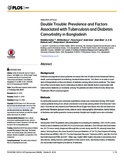| dc.contributor.author | Sarker, Malabika | |
| dc.contributor.author | Barua, Mrittika | |
| dc.contributor.author | Guerra, Fiona | |
| dc.contributor.author | Saha, Avijit | |
| dc.contributor.author | Aftab, Afzal | |
| dc.contributor.author | Latif, A. H. M. Mahbub | |
| dc.contributor.author | Islam, Shayla | |
| dc.contributor.author | Islam, Akramul | |
| dc.date.accessioned | 2018-01-02T08:56:34Z | |
| dc.date.available | 2018-01-02T08:56:34Z | |
| dc.date.issued | 2016-10-31 | |
| dc.identifier.citation | Sarker M, Barua M, Guerra F, Saha A, Aftab A, Latif AHMM, et al. (2016) Double Trouble: Prevalence and Factors Associated with Tuberculosis and Diabetes Comorbidity in Bangladesh. PLoS ONE 11(10): e0165396. https://doi.org/10.1371/journal.pone.0165396 | en_US |
| dc.identifier.other | 19326203 | |
| dc.identifier.uri | http://hdl.handle.net/10361/8867 | |
| dc.description | This article was published in the PLoS ONE [© 2016 PLoS ONE] and the definite version is available at : https://doi.org/10.1371/journal.pone.0165396 . The Journal's website is at: http://journals.plos.org/plosone/article?id=10.1371/journal.pone.0165396 | en_US |
| dc.description.abstract | Background
Diabetes among tuberculosis patients increases the risk of tuberculosis treatment failure, death, and development of multidrug-resistant tuberculosis. Yet, there is no data is available in Bangladesh on the prevalence of diabetes among tuberculosis patients. The objective of the current study was to estimate prevalence and identify factors associated with tuberculosis-diabetes co-morbidity among TB patients enrolled in the Directly Observed Treatment, Short course program.
Methods
A community based cross-sectional quantitative study was conducted among 1910 tuberculosis patients living in six urban and eleven rural areas among whom Oral Glucose Tolerance Test (those who fasted) and Random Blood Sugar test (those who did not fast) were performed. Besides glucose levels, data on socio-demographic information, family history of diabetes and anthropometric measurements (height and weight) were also collected.
Result
Among the 1910 TB patients who participated in screening for diabetes, 245 (12.8%) were found to have diabetes and 296 (15.5%) to have pre-diabetes. Out of those who had diabetes, 34.7% were newly diagnosed through the current study and 65.3% already knew their status. Among those who were found to have prediabetes, 27 (9.1%) had impaired Fasting Blood Glucose (FBG), 230 (77.7%) had Impaired Glucose Tolerance (IGT), and 39 (13.2%) had both Impaired FBG and IGT. Older age, higher BMI, higher education (secondary level and above), being married, participation in less active work, and family history of diabetes are associated with higher prevalence of diabetes.
Conclusion
We observed a higher prevalence of diabetes and pre-diabetes in TB patients than reported previously in Bangladesh among the general population which may challenge TB and diabetes control in Bangladesh. Diabetes diagnosis, treatment and care should be integrated in the National TB Program. | en_US |
| dc.language.iso | en | en_US |
| dc.publisher | BRAC Univeristy | en_US |
| dc.relation.uri | http://journals.plos.org/plosone/article?id=10.1371/journal.pone.0165396 | |
| dc.subject | Tuberculosis | en_US |
| dc.subject | Diabetes | en_US |
| dc.subject | Bangladesh | en_US |
| dc.title | Double trouble: prevalence and factors associated with tuberculosis and diabetes comorbidity in Bangladesh | en_US |
| dc.type | Article | en_US |
| dc.description.version | Published | |
| dc.identifier.doi | https://doi.org/10.1371/journal.pone.0165396 | |

